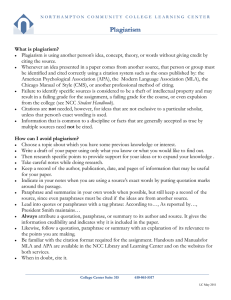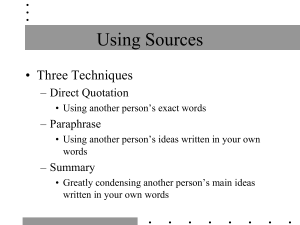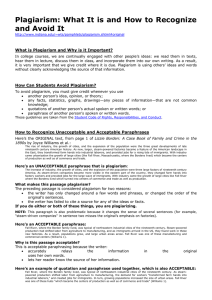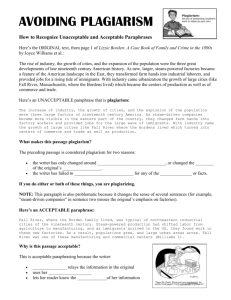Plagiarism: What It is and How to Recognize and Avoid It
advertisement
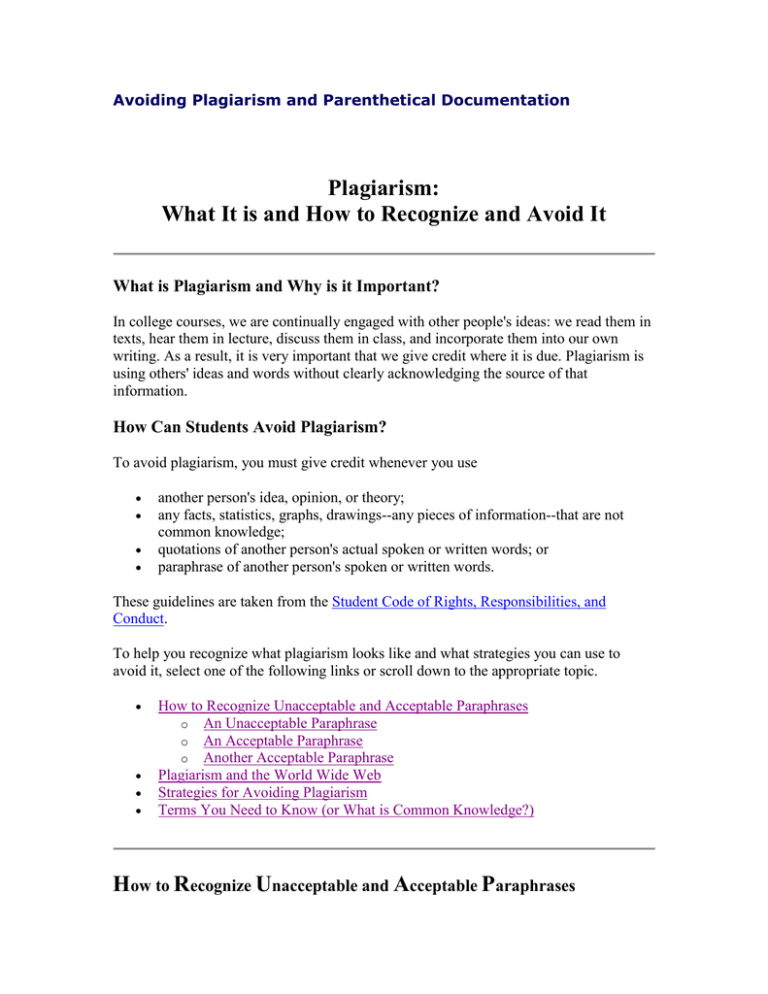
Avoiding Plagiarism and Parenthetical Documentation Plagiarism: What It is and How to Recognize and Avoid It What is Plagiarism and Why is it Important? In college courses, we are continually engaged with other people's ideas: we read them in texts, hear them in lecture, discuss them in class, and incorporate them into our own writing. As a result, it is very important that we give credit where it is due. Plagiarism is using others' ideas and words without clearly acknowledging the source of that information. How Can Students Avoid Plagiarism? To avoid plagiarism, you must give credit whenever you use another person's idea, opinion, or theory; any facts, statistics, graphs, drawings--any pieces of information--that are not common knowledge; quotations of another person's actual spoken or written words; or paraphrase of another person's spoken or written words. These guidelines are taken from the Student Code of Rights, Responsibilities, and Conduct. To help you recognize what plagiarism looks like and what strategies you can use to avoid it, select one of the following links or scroll down to the appropriate topic. How to Recognize Unacceptable and Acceptable Paraphrases o An Unacceptable Paraphrase o An Acceptable Paraphrase o Another Acceptable Paraphrase Plagiarism and the World Wide Web Strategies for Avoiding Plagiarism Terms You Need to Know (or What is Common Knowledge?) How to Recognize Unacceptable and Acceptable Paraphrases Here's the ORIGINAL text, from page 1 of Lizzie Borden: A Case Book of Family and Crime in the 1890s by Joyce Williams et al.: The rise of industry, the growth of cities, and the expansion of the population were the three great developments of late nineteenth century American history. As new, larger, steam-powered factories became a feature of the American landscape in the East, they transformed farm hands into industrial laborers, and provided jobs for a rising tide of immigrants. With industry came urbanization the growth of large cities (like Fall River, Massachusetts, where the Bordens lived) which became the centers of production as well as of commerce and trade. Here's an UNACCEPTABLE paraphrase that is plagiarism: The increase of industry, the growth of cities, and the explosion of the population were three large factors of nineteenth century America. As steam-driven companies became more visible in the eastern part of the country, they changed farm hands into factory workers and provided jobs for the large wave of immigrants. With industry came the growth of large cities like Fall River where the Bordens lived which turned into centers of commerce and trade as well as production. What makes this passage plagiarism? The preceding passage is considered plagiarism for two reasons: the writer has only changed around a few words and phrases, or changed the order of the original's sentences. the writer has failed to cite a source for any of the ideas or facts. If you do either or both of these things, you are plagiarizing. NOTE: This paragraph is also problematic because it changes the sense of several sentences (for example, "steam-driven companies" in sentence two misses the original's emphasis on factories). Here's an ACCEPTABLE paraphrase: Fall River, where the Borden family lived, was typical of northeastern industrial cities of the nineteenth century. Steam-powered production had shifted labor from agriculture to manufacturing, and as immigrants arrived in the US, they found work in these new factories. As a result, populations grew, and large urban areas arose. Fall River was one of these manufacturing and commercial centers (Williams 1). Why is this passage acceptable? This is acceptable paraphrasing because the writer: accurately relays the information in the original uses her own words. lets her reader know the source of her information. Here's an example of quotation and paraphrase used together, which is also ACCEPTABLE: Fall River, where the Borden family lived, was typical of northeastern industrial cities of the nineteenth century. As steam-powered production shifted labor from agriculture to manufacturing, the demand for workers "transformed farm hands into factory workers," and created jobs for immigrants. In turn, growing populations increased the size of urban areas. Fall River was one of these manufacturing hubs that were also "centers of commerce and trade" (Williams 1) Why is this passage acceptable? This is acceptable paraphrasing because the writer: records the information in the original passage accurately. gives credit for the ideas in this passage. indicated which part is taken directly from her source by putting the passage in quotation marks and citing the page number. Note that if the writer had used these phrases or sentences in her own paper without putting quotation marks around them, she would be PLAGIARIZING. Using another person's phrases or sentences without putting quotation marks around them is considered plagiarism EVEN IF THE WRITER CITES IN HER OWN TEXT THE SOURCE OF THE PHRASES OR SENTENCES SHE HAS QUOTED. Plagiarism and the World Wide Web The World Wide Web has become a more popular source of information for student papers, and many questions have arisen about how to avoid plagiarizing these sources. In most cases, the same rules apply as to a printed source: when a writer must refer to ideas or quote from a WWW site, she must cite that source. If a writer wants to use visual information from a WWW site, many of the same rules apply. Copying visual information or graphics from a WWW site (or from a printed source) is very similar to quoting information, and the source of the visual information or graphic must be cited. These rules also apply to other uses of textual or visual information from WWW sites; for example, if a student is constructing a web page as a class project, and copies graphics or visual information from other sites, she must also provide information about the source of this information. In this case, it might be a good idea to obtain permission from the WWW site's owner before using the graphics. Strategies for Avoiding Plagiarism 1. Put in quotations everything that comes directly from the text especially when taking notes. 2. Paraphrase, but be sure you are not just rearranging or replacing a few words. Instead, read over what you want to paraphrase carefully; cover up the text with your hand, or close the text so you can't see any of it (and so aren't tempted to use the text as a "guide"). Write out the idea in your own words without peeking. 3. Check your paraphrase against the original text to be sure you have not accidentally used the same phrases or words, and that the information is accurate. Terms You Need to Know (or What is Common Knowledge?) Common knowledge: facts that can be found in numerous places and are likely to be known by a lot of people. Example: John F. Kennedy was elected President of the United States in 1960. This is generally known information. You do not need to document this fact. However, you must document facts that are not generally known and ideas that interpret facts. Example: According the American Family Leave Coalition's new book, Family Issues and Congress, President Bush's relationship with Congress has hindered family leave legislation (6). The idea that "Bush's relationship with Congress has hindered family leave legislation" is not a fact but an interpretation; consequently, you need to cite your source. Quotation: using someone's words. When you quote, place the passage you are using in quotation marks, and document the source according to a standard documentation style. The following example uses the Modern Language Association's style: Example: According to Peter S. Pritchard in USA Today, "Public schools need reform but they're irreplaceable in teaching all the nation's young" (14). Paraphrase: using someone's ideas, but putting them in your own words. This is probably the skill you will use most when incorporating sources into your writing. Although you use your own words to paraphrase, you must still acknowledge the source of the information. Produced by Writing Tutorial Services, Indiana University, Bloomington, IN Return to "Writing Resources" page Return to WTS home page Setting up your parenthetical documentation Using a signal phrase To introduce cited material consisting of a short quotation, paraphrase, or summary, use either a signal phrase set off by a comma or a signal verb with a that clause, as in the following examples. (See 4e for a discussion of signal phrases and verbs.) According to Steven E. Landsburg, "if you know you're going to treasure something, you don't hesitate to buy it."(p. ?) In his January 1991 letter to the editors of PMLA, Jason Mitchell suggests that the "pretentious gibberish" of modern literary critics-"Eurojive," as he calls it--is often produced by English professors who need to prove that their professional status is equal to that of math and science faculty. Using a parenthetical citation To identify the source of a quotation, paraphrase, or summary, place the author's last name in parentheses after the cited material. Put a page number after the name from the page where you found the information. "Parents know in advance, and with near certainty, that they will be addicted to their children" (Landsburg, 15). In response to Victor Brombert's 1990 MLA presidential address on the "politics of critical language," one correspondent suggests that "some literary scholars envy the scientists their wonderful jargon with its certainty and precision and thus wish to emulate it by creating formidably technical-sounding words of their own" (Mitchell, 3). Author’s name is in the intro or set up 8.2.1. 8.2.6. If you include an author’s name in a sentence, do not repeat it in the parentheses. Ex: It may be true, as Schama writes, that “. . . the consequences of the Revolution from 1789 to the Terror were . . . socially conservative” (518). Using a long quote (Often looked upon as filler) 8.1.6. 8.1.7. Set off a prose quotation of five or more typed lines by beginning a new line and indenting each line ten spaces from the left margin. Double space the quotation, place an end mark before the documentation and do not use quotation marks. Ex: At the outset of “The Tell-Tale Heart” the narrator defends his own sanity: True! – nervous – very, very dreadfully nervous I had and am: but why will you say that I am mad? The disease had sharpened my senses – not destroyed – not dulled them. Above all was the sense of hearing acute. I heard all things in the heaven and in the earth. I heard many things in hell. How, then, am I mad? Hearken! and observe how healthily – how calmly I can tell you the whole story. (Poe 203) Using an author or source two or more times 8.2.2. 8.2.7. If you document from the same source two or more items successively, use only the page number to document the second item. Ex Recent research indicates that the magnetic field of ancient Mars “ . . . dovetails with – but does not prove biological origin for magnetic minerals . . .” (Cowen 190). It may also be true that the bacteria- produced magnetite was used as some sort of navigational guide (191).
